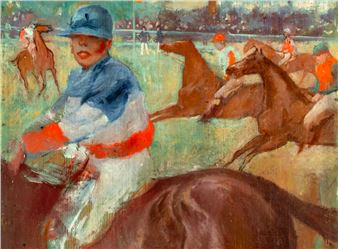Antoni °ХГ ұиҫұұрІх: LвҖҷEsperit CatalГ
From the early stages of his career, Antoni °ХГ ұиҫұұрІхвҖҷs works were associated with вҖңstreet graffiti and a whole world of repressed, clandestine protest; a world full of life that moved around the walls of my countryвҖқ, as he himself put it in his ComunicaciГіn sobre el muro (CommuniquГ© on the Wall, 1969). Urban walls became places for political and personal messages, similar to the kind of things BrassaГҜ photographed in the 1930s; what the artist does is to transfer such messages directly to the painting. вҖңEvery wall of a city that family tradition had made me think of as my own, was a witness to the martyrdoms, to the sheer inhuman backwardness inflicted on our peopleвҖқ.
°ХГ ұиҫұұрІх made The Catalonian Spirit in 1971. Essentially, it is a wall reflecting Catalonian life in the last few years of the Franco regime. Marked by the four vertical bars of the Catalonian flag, the painting is full of messages, some large, like вҖңlibertat (freedom)вҖқ, вҖңCatalunya viu (Catalonia lives)вҖқ and вҖңVisca Catalunya (Viva Catalonia)вҖқ. In general, the messages are about spiritual and political renewal: dialogue, social equality, democracy, truth and culture. The painting is thus a political and aesthetic manifesto: a вҖңtrue Guernica for the resistanceвҖқ, in Josep MeliГ вҖҷs words.
In opposition to those who understand the avant-garde in all its manifestations as an essentially internationalistand therefore apolitical movement, °ХГ ұиҫұұрІх argued in favour of the artist being firmly rooted in his own land, as he wrote in another article of the time (El arte de vanguardia y el espГӯritu catalГЎn (Avant-garde art and the Catalonian spirit), 1971): вҖңPatriotic feeling to be brutally frank in our country at least and despite what the less patient among us might believe, is also still at bottom a preserve of the progressivesвҖқ. And this, for °ХГ ұиҫұұрІх, is not localism, but rather an attempt to вҖңkeep the essential battle alive, be it in love or war, on behalf of humanism, democracy and freedomвҖқ.
For °ХГ ұиҫұұрІх, the primordial function of the artist is not to talk about himself, but to appear as the вҖңalmost anonymousвҖқ spokesman for the вҖңcollectiveвҖқ. And this is what happens in The Catalonian Spirit, which presents us with an urban wall that provides a space for the anonymous demands of the people.

Recommended for you
From the early stages of his career, Antoni °ХГ ұиҫұұрІхвҖҷs works were associated with вҖңstreet graffiti and a whole world of repressed, clandestine protest; a world full of life that moved around the walls of my countryвҖқ, as he himself put it in his ComunicaciГіn sobre el muro (CommuniquГ© on the Wall, 1969). Urban walls became places for political and personal messages, similar to the kind of things BrassaГҜ photographed in the 1930s; what the artist does is to transfer such messages directly to the painting. вҖңEvery wall of a city that family tradition had made me think of as my own, was a witness to the martyrdoms, to the sheer inhuman backwardness inflicted on our peopleвҖқ.
°ХГ ұиҫұұрІх made The Catalonian Spirit in 1971. Essentially, it is a wall reflecting Catalonian life in the last few years of the Franco regime. Marked by the four vertical bars of the Catalonian flag, the painting is full of messages, some large, like вҖңlibertat (freedom)вҖқ, вҖңCatalunya viu (Catalonia lives)вҖқ and вҖңVisca Catalunya (Viva Catalonia)вҖқ. In general, the messages are about spiritual and political renewal: dialogue, social equality, democracy, truth and culture. The painting is thus a political and aesthetic manifesto: a вҖңtrue Guernica for the resistanceвҖқ, in Josep MeliГ вҖҷs words.
In opposition to those who understand the avant-garde in all its manifestations as an essentially internationalistand therefore apolitical movement, °ХГ ұиҫұұрІх argued in favour of the artist being firmly rooted in his own land, as he wrote in another article of the time (El arte de vanguardia y el espГӯritu catalГЎn (Avant-garde art and the Catalonian spirit), 1971): вҖңPatriotic feeling to be brutally frank in our country at least and despite what the less patient among us might believe, is also still at bottom a preserve of the progressivesвҖқ. And this, for °ХГ ұиҫұұрІх, is not localism, but rather an attempt to вҖңkeep the essential battle alive, be it in love or war, on behalf of humanism, democracy and freedomвҖқ.
For °ХГ ұиҫұұрІх, the primordial function of the artist is not to talk about himself, but to appear as the вҖңalmost anonymousвҖқ spokesman for the вҖңcollectiveвҖқ. And this is what happens in The Catalonian Spirit, which presents us with an urban wall that provides a space for the anonymous demands of the people.
Artists on show
Contact details















